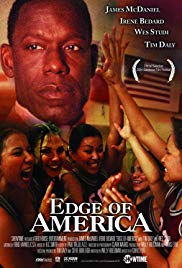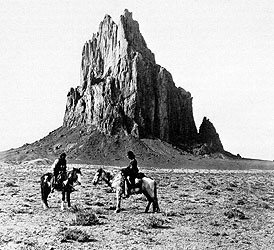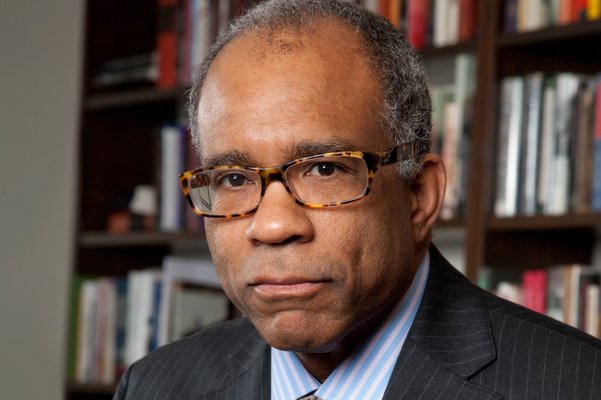1. See Standard Questions Suitable for Any Film.
2. What do you think of the character of Mother Tsosie? Have you ever known anyone like her?
Suggested Response:
Mother Tsosie is a traditional weaver and a spiritual leader of the community. She seems to be in touch with herself and can change when she realizes that change is for the best. For example, she allows her daughter “Baby” to play basketball, even though Mother Tsosie knows that it will erode the traditions that she holds so dear.
3. Mother Tsosie refers to “Mother Earth” — What is “Mother Earth”?
Suggested Response:
Mother Earth, or the earth goddess, is the bountiful embodiment of the Earth. See Helpful Background Section of the Learning Guide for a Navajo description of Mother Earth.
4. What do you think about the following dialog? Is Annie Shorty right to reprimand Mr. Williams?
Kenny Williams: Then you tell me why I’m pissed off.
Annie Shorty: Because you’re a black man in America.
Kenny Williams: That’s right, I’m good and pissed off.
Annie Shorty: Well then get over it! You’re talking to Indian people here! Get over it, get on with it, or get the hell out!
Suggested Response:
There is no one correct answer to this question. Some points to make are that the human rights of both African Americans and Native Americans have been violated on many occasions by the white majority in the U.S. Black people were taken from their homes in Africa and enslaved. Later, during the time of segregation, blacks were not afforded equal rights. The effort to provide equal rights to Black Americans is an ongoing struggle. Native Americans were decimated, their land was taken away, and their cultures severely compromised. The character of Kenny Williams was accustomed to relating to a culture dominated by white people. There was no basis for Mr. Williams to be angry at Native Americans who had suffered great oppression from the whites.
Black people in the United States are an integral part of the mainstream culture. Native Americans on the reservations are not. Gambling enterprises are now making many Native American tribes rich at the expense of white and black Americans. [At TWM we call the Indian gambling casinos the “white man’s fire water”. Many people in the mainstream culture are unable to curb their urge to gamble, as many Native Americans were unable to deal with alcohol.]
5. Mr. Williams says: “Basketball never did a … thing for me that a book didn’t do better.” What did he mean by this and what is the significance of this comment for most people?
Suggested Response:
Education, which primarily comes from books, is a better way to get a reasonable standard of living for all but the lucky and talented few who can succeed in professional sports or who can coach. Mr. Williams is speaking for the vast majority of successful people in the U.S. who make their living based upon education or training in an occupation other than sports.
6. Mr. Williams told Mother Tsosie that every time Baby set foot on a basketball court she had perfection within reach. Mother Tsosie replied that: “I weave my whole life and soon I make mistake but I make it on purpose. My spirit would be trapped in a perfect design. A flaw lets it out. Flaws keep our feet on Mother Earth.” What are the advantages of the drive for perfection? What is mother Tsosie talking about?
Suggested Response:
The drive for perfection can inspire people to achieve things they wouldn’t normally be able to achieve. However, as Mother Tsosie points out, the drive for perfection can confine us to a limited focus that virtually imprisons us. There are, for example, many things in life other than basketball or sports. A person who focuses all of his or her attention on becoming perfect at basketball or any other sport, will ignore much of the rest of life and miss it.
7. What’s going on with Franklin?
Suggested Response:
Franklin has no family. He is angry and rebellious as many young men are, but especially because he is Native American. He resents this man (Mr. Williams) from the mainstream culture (a “white man” to the Navajo) coming into his community and changing things, taking time away from his girl.
8. Mr. Williams was rough with the girls and demanded that they meet high standards. Why did he do this? There are at least two reasons.
Suggested Response:
High standards were necessary for the team to win. It would be good for the girls to learn discipline and that they could be successful if they tried hard.
9. What was the importance of what happened to Mr. Williams in Texas when his car broke down and a man pulled over to give him a hand? He said, “I had the whole world worked out black and white. I knew exactly who my enemy was.”
Suggested Response:
The man who stopped to help him was white and was killed while he was trying to help. Mr. Williams realized that not all white people were his enemy.
10. The movie shows how much Mr. Williams was a product of the mainstream culture in the U.S. Give some examples.
Suggested Response:
Here are two: his drive to win (to become perfect as he describes it to Mother Tsosie) and his intolerance of Native American culture.
11. What did you think of the character of Carla’s father?
Suggested Response:
He was white, which is ironic, because he was the only alcoholic character in the movie. (Alcoholism is a problem for Native Americans and most people believe that the rate of alcoholism is higher on the reservation than in the general population.) He loved his daughter. He was in mourning for his wife who had died recently. He eventually supported Carla’s efforts at basketball. He took responsibility for bringing the beer into the car when he and Franklin were stopped by the police.
12. Why did Mr. Williams help Carla’s boyfriend get out of the jail?
Suggested Response:
There were several reasons. First, it was the right thing to do. The boy’s infraction didn’t merit staying in jail for a week and he had no family to help him get out of jail. Second, Mr. Williams wanted to support Carla. She was on his team and he had promised that he would be there for her if she needed help. Franklin was her boyfriend and helping Franklin was a way of caring for his team. Mr. Williams also wanted to defuse Franklin’s anger at him.
13. Was the loss really the coach’s fault for telling the girls to slow the game down and play for one shot? Does it matter?
Suggested Response:
There is no one correct answer to the first question. If it was the coach’s fault, he was owning up to his responsibility. If it wasn’t his fault, he was taking the blame to make sure that the girls didn’t blame themselves. But there is another way to look at it, that the team played a great game and a great season. The loss was no one’s fault. The other team was just one point better on that particular day. The entire season was a great triumph for the girls and they deserved to think of themselves as winners. And of course, this is what the town (undoubtedly led by Mother Tsosie and Cuch) thought.
14. Close to the end of the championship game, Annie Shorty said that she really wanted to beat the other team’s coach. Then she said, “God help me, I want to beat that … Tell me this is still about education.” What did she mean by that?
Suggested Response:
She meant that high school sports should not be about winning, it should be about educating the kids. Winning is secondary. Her comment recognizes that sometimes it’s hard to keep the competitive spirit from getting the upper hand.
15. In a basketball game decided by one point, is one team really better than the other, or is it just the luck of timing that makes the winner?
Suggested Response:
This will be the subject of debate. The very competitive will say that the one point matters and the less competitive will say that it doesn’t. TWM votes with the latter.
16. Were the people on the reservation right to treat the girls as winners?
Suggested Response:
Absolutely. They had done better than ever before. They had played better than anyone expected. They had played at the top of their abilities.
17. Cuch, the wise man/auto mechanic/bus driver, was forced to go to a Bureau of Indian Affairs boarding school. The first thing they did was to cut his hair. For a Native American, this robs him of his individuality and humanity. But in the movie, Cuch is much older and on his own. He has had plenty of time for his hair to grow back. But he keeps it cut relatively short. In addition, Cuch makes his living working on cars, the quintessential representative of the mainstream culture. These two elements of the story are symbols. But of what? Here’s a hint: they relate to the decision of Mother Tsosie to allow Baby to go back to school and to play basketball despite the fact that Mother Tsosie knows that playing on the team and going to school will dilute Baby’s Native American traditions. What theme of the movie does this relate to? What does Cuch’s short hair symbolize?
Suggested Response:
A theme of the film is that Native American culture must adopt some of the ways of the mainstream culture. Cuch’s hair and his job are primary symbols for this.







